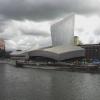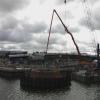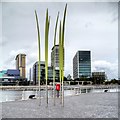
Imperial War Museum North
Address is taken from a point 299 yards away.

| Sewage Works | 7 furlongs | |
| Weaste Wharf | 6½ furlongs | |
| Mode Wheel Locks | 3 furlongs | |
| Media City Footbridge | ¾ furlongs | |
| Dock No 9 Entrance | ½ furlongs | |
| Imperial War Museum North | ||
| The Lowry | ¼ furlongs | |
| Salford Quays Footbridge | ¾ furlongs | |
| Dock No 8 Entrance | 1½ furlongs | |
| Turning Basin | 2½ furlongs | |
| Trafford Road Swing Bridge | 5¼ furlongs | |
Amenities nearby at The Lowry
Why not log in and add some (select "External websites" from the menu (sometimes this is under "Edit"))?
Mouseover for more information or show routes to facility
Nearest water point
In the direction of Woden Street Footbridge
Nearest rubbish disposal
In the direction of Woden Street Footbridge
Nearest chemical toilet disposal
In the direction of Woden Street Footbridge
Nearest place to turn
In the direction of Woden Street Footbridge
Nearest self-operated pump-out
In the direction of Woden Street Footbridge
Nearest boatyard pump-out
In the direction of Woden Street Footbridge
Wikipedia has a page about Imperial War Museum North
Imperial War Museum North (sometimes referred to as IWM North) is a museum in the Metropolitan Borough of Trafford in Greater Manchester, England. One of five branches of the Imperial War Museum, it explores the impact of modern conflicts on people and society. It is the first branch of the Imperial War Museum to be located in the north of England. The museum occupies a site overlooking the Manchester Ship Canal on Trafford Wharf Road, Trafford Park, an area which during the Second World War was a key industrial centre and consequently heavily bombed during the Manchester Blitz in 1940. Just across the Trafford Wharf Road from the Museum is the bulk of the Rank Hovis Flour Mill, a survivor from a former industrial age and now rather out of keeping with the surrounding architecture. The area is now home to the Lowry cultural centre and the MediaCityUK development, which stand opposite the museum at Salford Quays.
The museum building was designed by architect Daniel Libeskind and opened in July 2002, receiving 470,000 visitors in its first year of opening. It was recognised with awards or prize nominations for its architecture and is a prime example of Deconstructivist architecture. The museum features a permanent exhibition of chronological and thematic displays, supported by hourly audiovisual presentations which are projected throughout the gallery space. The museum also hosts a programme of temporary exhibitions in a separate gallery. Since opening, the museum has operated a successful volunteer programme, which since January 2007 has been run in partnership with Manchester Museum. As part of a national museum, Imperial War Museum North is financed by the Department for Culture, Media and Sport and by self-generated income. Admission is free.



![Manchester Ship Canal at Salford Quays. Amongst the landmarks visible on the opposite side of the canal are [[[2684946]]], [[[2398553]]] and [[[1660068]]]. by David Dixon – 07 February 2014](https://s3.geograph.org.uk/geophotos/03/84/12/3841203_6fa99bc2_120x120.jpg)

![Salford Quays. Looking along the Manchester Ship Canal, from the Salford Quays (MediaCityUK) bank. On the left is the Lowry Centre ([[[1698343]]]), ahead is the Lowry Bridge ([[[2684946]]]) and on the Trafford side, the Quay West Offices ([[[2398553]]]). by David Dixon – 21 October 2012](https://s2.geograph.org.uk/geophotos/03/19/77/3197774_09f7c28a_120x120.jpg)




![Cruising Past Imperial War Museum North. City Centre Cruise trip boat “Emmeline Pankhurst†passes the Imperial War Museum North building as it makes the return journey from MediaCityUK to Castlefield.Opened in July 2002, IWM North is one of the five branches of the Imperial War Museum, the first to be located in the north of England. The museum explores the impact of modern conflicts on people and society. The museum site overlooks the Manchester Ship Canal and the former Manchester Docks in Trafford Park, an area which was a key industrial centre during the Second World War and consequently was heavily bombed during the Manchester Blitz in 1940.The museum building was designed by architect Daniel Libeskind. Its striking design provokes mixed reactions; it has been recognised with awards or prize nominations for its architecture, but has also been criticised for poor energy efficiency. The concept for the design, not to everyone’s taste is “that of a globe shattered into fragments and then reassembled on that site as an iconic emblem of conflict. The building is the interlocking of three shards representing earth, air, and waterâ€.The museum features a permanent exhibition of chronological and thematic displays, supported by hourly audiovisual presentations which are projected throughout the gallery space. The museum also hosts a programme of temporary exhibitions. Both the exterior (particularly from the waterside [[[1660068]]]) and interior of the building provide a stimulating experience for visitors. As part of a national museum, Imperial War Museum North is financed by the Department for Culture, Media and Sport and by self-generated income and, currently, admission is free.http://www.iwm.org.uk/visits/iwm-north - IWM North official web site. by David Dixon – 17 July 2015](https://s2.geograph.org.uk/geophotos/04/57/65/4576502_09613436_120x120.jpg)













![Manchester Ship Canal, Trafford Wharf. Looking across the Manchester Ship Canal from pier 9 (outside the Lowry Centre) at Salford Quays. [[[4516036]]], [[[2856882]]] and [[[2398578]]] are all prominent on the opposite side of the canal (Trafford Wharf). by David Dixon – 24 September 2015](https://s3.geograph.org.uk/geophotos/04/67/83/4678335_59afcfba_120x120.jpg)






